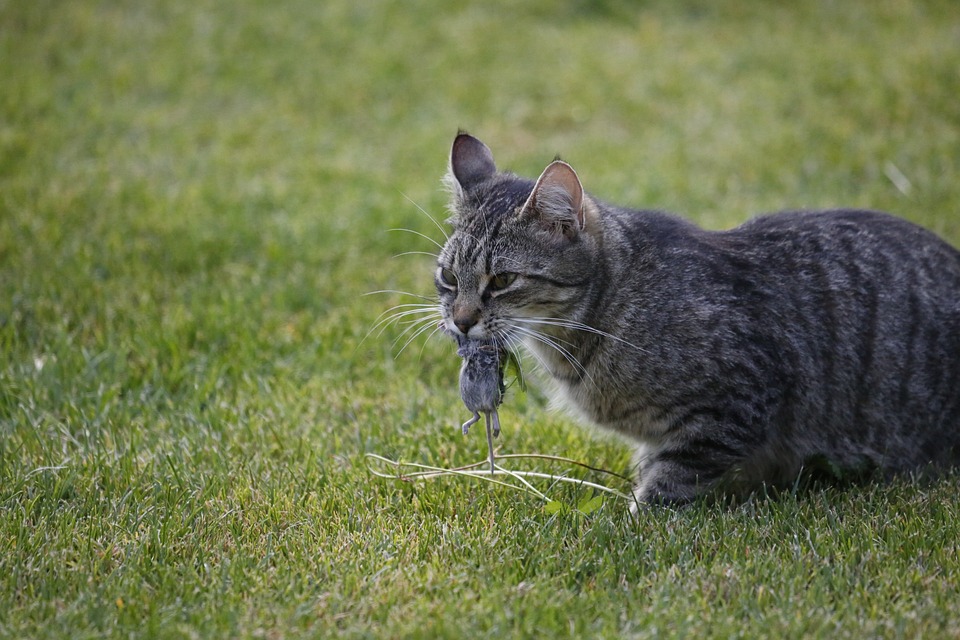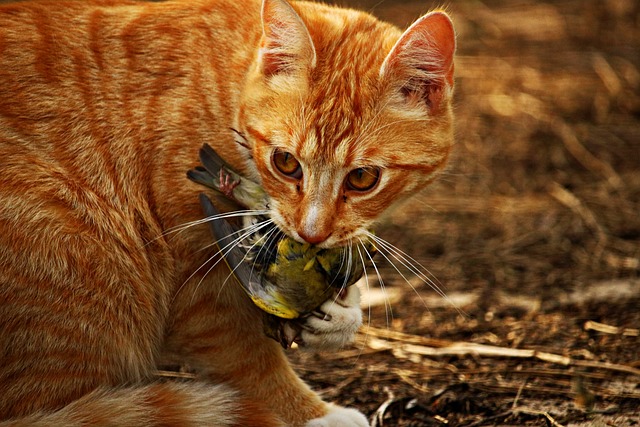Understanding Your Cat’s Hunting Instinct
Cats are carnivorous predators who use hunting techniques to catch their prey. They can be more or less proficient, making them either an inveterate hunter who preys mainly on rodents and birds or an occasional hunter with no predatory instinct, content to play with their victims. How not to repress his hunting instinct while curbing his predation?
All the information in our article.
Cat, predation, and hunting
Predation is a way of feeding, and hunting is a way to catch preys:
Predation is triggered by hunger, by the need to eat to survive.
Hunting is triggered by movement, a reaction to a moving stimulus.
The better the cat is at hunting, the more rewarding this activity is, the more time it will spend doing it, and the less dependent it will be on humans.
If the cat is poor at hunting, it will be an occasional hunter who will be content to catch insects and lizards and will prefer to engage in alternative activities such as play. It will spend more time in the company of humans.
Cat hunting and predation ecology
There are active preys at all times of the day, both day and night, and the cat will seize any opportunity, but its predatory activity is at its greatest at dawn and dusk because many of its prey are active at that time. This is the time when many species move around the most. For example, the rats are diurnal and nocturnal but mainly crepuscular. Those living underground come out to drink, look for food, and defecate.
The preys of choice for the cat are rodents and birds:
The rodents pullulate in the cultures and meadows devoted to pastoralism. They are considered pests by the farmers who welcomed the cats, which led to their domestication.
Birds are not easy prey to catch. Cats spot young or sick birds weakened by migrations or harsh winters. Some species are threatened with extinction by the presence of the cat, which has accompanied man in his travels throughout the world and the ages, which has led in some habitats to the destruction of its endemic fauna, especially on the islands where cats have wreaked havoc on birds and their eggs on which they feed. The cat has become a pest to these particular ecosystems.
The cat is undoubtedly crepuscular because it is itself a prey. When it hunts, it cannot be very attentive and careful because its attention is focused on its prey. It is less exposed in half-light or darkness, where it is easier to mask its presence to its own predators (dog, fox, wolf, lynx, raccoon dog, raptors, great horned owl, marten, badger, and human hunters).
Night vision is an adaptation to predation: rods are photoreceptors that line the retina and allow for twilight and night vision. However, minimum light is necessary because the cat does not see in absolute darkness. This is why they are most active at dawn and dusk. Its night hunts are only possible if the moon illuminates the area sufficiently or if the cat is close to a light source such as public lighting.
Cat: a hunter by nature?
The cat is a crepuscular, daytime, and nighttime hunter. Its body is equipped for this activity:
It has a daytime vision focused on movements and a night vision thanks to the rods.
It has mobile ears and vibrissae that detect noises and air movements and evaluate the distance of the prey.
It has foot pads that detect ground vibrations caused by the movement of the prey.
It is digitigrade, which makes its approach silent, and facilitates its jumps on the victim.
It has claws that hold and immobilize the prey.
It has a carnivorous dentition and digestive system, which allows it to crunch the prey and ingest it with feathers and skin.
If the cat is in predatory mode, in general, it hunts on the lookout:
- It waits in front of the entrance to a rodent gallery.
- It climbs to the top near a place of usual passage of a prey.
- It waits on the roof for the birth of chicks in a nest.
The cat is extremely patient and tenacious, and when it catches its prey, it consumes it.
The character of the cat

The character of the cat makes it an outstanding hunter:
The cat is an opportunist. If it sees a prey item, it may approach it slowly and cautiously, chasing it down and jumping on it. The cat uses this stalking to capture birds nesting on the ground.
Curious and playful, some stimuli easily trigger acts of hunting: a noise or a movement arouses his curiosity. The cat does not seek to know what it is but to capture what moves. Once caught, the animal caught does not move because it is tetanized by fear or pretends to be dead. But the cat, thanks to the receptors in its paw pads, knows it is luring it and tries to solicit movements to continue its game: it lets the animal escape to catch it better, wakes it up with its paws, and throws it in the air. The game ends when the animal dies or because the cat is bored. The corpse is left intact.
Role of the mother
The mother cat has a role in allowing her kittens to practice hunting techniques: she simply brings prey but does not usually demonstrate how to make the kill.
Nowadays, the hunting behavior of pet cats is no longer induced by the mother cat living in a house: she is more busy caring for and protecting her litter than hunting because she no longer needs to do so. After all, her owners are taking care of her needs. She will only start to bring prey after 7 to 8 weeks, the age at which her kittens are usually adopted, and therefore do not have the opportunity to learn. In addition, many owners would not allow their cat to bring home a mouse to watch this cruel spectacle.
Factors such as hunting experience and opportunity, availability of prey, and the need for dietary variation will determine whether the cat will be a good predator.
Limiting the predation of the hunting cat
You can’t curb a cat’s hunting instinct, but be aware that “failure breeds failure” and opportunity is the key:
If you don’t want your cat to become an experienced hunter, you should put a collar with a bell on it from the start. This won’t stop him from catching crawlers and insects but will certainly compromise his success with birds and rodents.
If your cat brings you a dead prey item as a gift, ignore it, and pretend not to see the cat: don’t talk to it or reward it. Remove the corpse once the cat is busy with another activity.
If the cat brings you a live prey item, capture it, hold it in a small box, and release it into the wild, away from its hunting grounds. Lock the cat up for the rest of the day.
Avoid letting it out at dawn and dusk.
Play with it often. Reward it with something different from its normal diet, something more appetizing: a treat, a piece of meat.
For a cat that eats its prey, try switching to wet food or “Barf diet. Sometimes this reduces predation.
